Dichondra 'Silver Falls' - Dichondra argentea
Ice Plant - Delosperma floribunda 'Sequins'
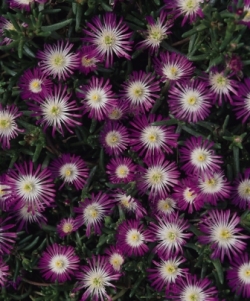 Delosperma 'Sequins' Picture courtey Ball StraathofThe hardy Ice Plants are native to dry areas in South Africa.
Delosperma 'Sequins' Picture courtey Ball StraathofThe hardy Ice Plants are native to dry areas in South Africa.
A striking new introduction in the vygie range is the Delosperma floribunda 'Sequins' selection. The glistening deep purple flowers each have a large white center, and will flower almost the entire summer long; with hundreds of flowers being produced on a single plant. The flowers will attract butterflies and bees to your garden.
This selection forms a low mat of succulent evergreen leaves that spread quickly, making it an excellent groundcover for hot, dry slopes and sandy soils.
For a groundcover, space the plants 45 to 60cm apart. 'Sequins' is lovely if grown in tubs and mixed containers, in the rock garden, or as an edging plant.
This ice plant will grow about 10 to 15cm tall and can spread 45 to 60cm. It is a low maintenance plant that is extremely hardy to heat, cold and frost; and is very drought tolerant. Plant it in full sun and well-drained soil. It should not be over watered and only needs fertilising once a month. In regions with wet soils in winter this will likely perform as an annual.
Chinese Ground Orchid - Bletilla striata
Wild Iris, Wilde-Iris, Isiqungasehlati
Agapanthus, Bloulelie - Agapanthus subsp.
Rock Rose, White Mexican Rose - Echeveria elegans
Sedges - Carex
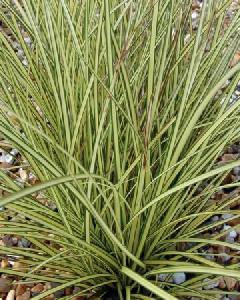 Carex brunnea 'Jenneke' Picture courtesy MalanseunsDescription, History & Interesting Facts:
Carex brunnea 'Jenneke' Picture courtesy MalanseunsDescription, History & Interesting Facts:
Carex are extremely attractive perennial plants which belong to the Sedge family; with over 1000 species and even more cultivars. Most species are evergreen, and can be found growing from the coldest climates and high elevations, to the tropics; so there's one or two suitable for every garden.
All sedges are essentially grass-like in appearance and range in size from extremely small tufts to large clumps. Most garden varieties have striking foliage, a compact mounding habit and cascading leaves.
Foliage can be bronze-brown, dark to light green; or striped with green and cream, ivory or golden-yellow.
In summer the plants produce small brown flower spikes which are attractive but fairly inconspicuous.
(Carex oshimensis 'Variegata')
Variegata has cream and green leaves and the same characteristics and growing requirements as 'Evergold'
 Carex comans 'Bronze' Picture courtesy Malanseuns(Carex oshimensis 'Evergold
Carex comans 'Bronze' Picture courtesy Malanseuns(Carex oshimensis 'Evergold
Evergold is native to the Japanese main island of Honshu and the islands of Shikoku and Kyushu. It is common in dry woods and rocky hillsides at low altitudes, and therefore prefers a slightly drier soil than most sedges. This evergreen has fine foliage which cascades softly to the ground in a fountain-like manner. The striped, creamy-yellow leaves have dark green margins. Its compact growth habit +-15 to 20cm tall and +-20 to 30cm wide, make it an excellent choice for the front of the border. It is fully hardy to frost and thrives in to semi-shade to shade.
(Carex comans Bronze Form) Bronze New Zealand Hair Sedge
This evergreen sedge is native to New Zealand and provides year-round interest with its narrow, weeping leaves which form a dense tussock. The leaves are a warm honey-amber which changes to the shiny copper colour of a new penny in early spring when the new leaves emerge. It will grow in sun or semi-shade to +-30 to 40cm tall and +-50 to 60cm wide. It will adapt to most garden soils and is very hardy to frost, tolerating temperatures down to -5°C; in very cold regions it will go dormant in winter. This sedge does not enjoy excessive wetness in winter.
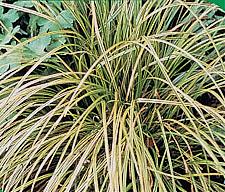 Carex 'Gold Fountain'(Carex comans 'Frosted Curls') New Zealand Hair Sedge
Carex 'Gold Fountain'(Carex comans 'Frosted Curls') New Zealand Hair Sedge
This eye-catching evergreen sedge is native to New Zealand and provides year-round interest with its narrow, pale silvery-green leaves which curl at the tips; shimmering in even the slightest breeze. It forms low matted tufts, which weep as it grows taller. Frosted Curls will grow in sun or semi-shade to +-30cm tall; it can take 4 to 5 years to reach its ultimate height of +-60cm, with a spread of 45cm. Plant it in moist, fertile, well-drained soils, in full sun or semi-shade. This sedge is hardy to frost but in very cold regions it will go dormant in winter.
(Carex brunnea 'Jenneke')
This splendid evergreen sedge makes tufts of slender upright green leaves, which are edged with golden-yellow; when the light catches them, it brilliantly highlights the foliage. Jenneke is hardy to frost and more drought tolerant than most sedges, but responds well to moderate watering in the garden. It can be planted in semi-shade to sun and grows +-40cm tall and 20cm wide; once mature it can exceed these proportions
In the Garden:
Sedges are striking contrast plants for all types of gardens and combine well with other perennials. They are not limited to one garden style and are used in Japanese pebble gardens, tropical and ultra modern designs; cottage and woodland gardens.
They prefer moist soil and thrive near water features and ponds. They also provide an effective groundcover if planted in massed beds; doing well underneath trees. Their compact mounding habit makes them an excellent choice for the front of the border.
Sedges are also great accent plants for mixed container plantings with perennials and annuals.
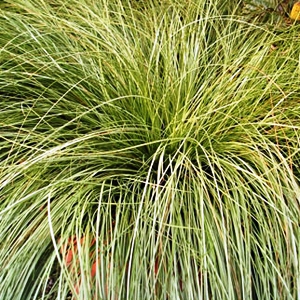 Carex comans 'Frosted Curls' Cultivation/Propagation:
Carex comans 'Frosted Curls' Cultivation/Propagation:
Cultural requirements vary from species to species and most garden varieties available in South Africa remain evergreen and are hardy to frost; in very cold regions they may become dormant in winter.
Some cultivars love semi-shade and will even grow in full shade, while others will adapt to full sun.
Most Sedges love moisture and grow happily in wet, boggy areas, while others are more drought tolerant. Generally they adapt to most fertile well-drained garden soils, from sand to clay loam.
Your local garden centre will stock those varieties most suitable for your region, so check with them first.
Like most perennial grasses sedges will benefit from a tidy up in the spring to remove any dead foliage and to encourage new growth.
Propagation is by seed or by division of the root ball in autumn or spring.
Japanese Sweet Flag, Japanese Rush - Acorus gramineus
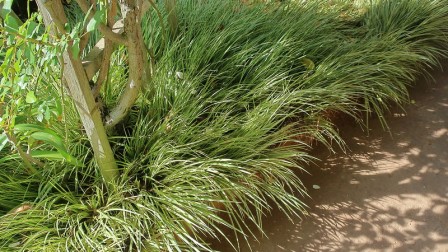 Acorus gramineus 'Variegatus' covers the ground below a pillar rose. Picture courtesy K M from flickrCondensed Version:
Acorus gramineus 'Variegatus' covers the ground below a pillar rose. Picture courtesy K M from flickrCondensed Version:
Grown primarily for its bright and cheery evergreen foliage that is clumping and grass-like in character, the sweet flag does just as well in water as it does in garden beds, and grows easily virtually throughout South Africa, as long as it can be watered regularly. It does not perform well in dry soils and will need regular watering in summer in the winter rainfall regions, and the drier summer rainfall regions of the country.
The green-leaved Acorus gramineus is fully hardy to frost and temperatures down to -15°C, but the golden varieties may get scorched by severe frost, but will quickly shoot again in spring if the roots are well mulched in autumn.
The sweet flag is great in coastal gardens because it tolerates salt winds with ease, and in coastal landscapes it thrives in beds on the shady side of the house.
Even though Acorus will grow in semi-shade and full sun, it does not like intense heat, so in very hot areas plant it where it will receive some shade during the hottest part of the day, or dappled sunlight throughout the day. Dry soils coupled with intense sunlight will scorch the foliage.
The plants will adapt to soils ranging from very acidic (pH 5.2 to 5.5) to alkaline (pH 8.1 to 8.5) and will flourish in most fertile garden soils, even heavy clay. Add generous amounts of compost to the beds before planting to help conserve water, and for a groundcover space the plants about 20 to 30cm apart, depending on the variety grown.
Full Version:
Description, History & Interesting Facts:
Acorus gramineus goes by many common names like: Japanese Sweet Flag, Japanese Rush, and Grassy-leaved Sweet Flag. It belongs to the genus Acorus, and now has its own family group (Acoraceae), although it used to be classified as part of the Arum family. It is native to eastern Asia, specifically China, Japan, Korea, India, Thailand, Myanmar, and the Philippines, where it favours growing in wetlands and shallow water.
This attractive, grass-like little plant only grows about 30cm in height and the long, narrow green leaves grow in flattened fans like those of irises, crowded along short rhizomes (roots). Both the leaves and rhizomes emit a sweet citrus scent when crushed or bruised, hence the common name sweet flag. Tiny, insignificant, yellow-green flowers appear from spring to early summer on lateral flower spikes (spadixes), and give way to very tiny, fleshy, reddish berries.
Acorus gramineus ‘Golden Edge’ has slightly curved foliage that ranges in colour from light to golden yellow, and is striped with green. The tussocks, or clumps, grow to about 30cm tall and wide.
Acorus gramineus ‘Variegatus’ grows about 25 to 30cm tall and wide, forming a low mound of narrow sword-shaped leaves, striped lengthwise with green and creamy-white.
Acorus gramineus ‘Mini-Gold’ is a cheeky looking little dwarf with yellow and gold leaves and an adult size of around 15cm tall and wide.
Acorus gramineus 'Liquorice' is known as “Sekisho” in Japan where the liquorice flavour of the rhizomes and leaves are used in cooking. The rhizomes are roasted or stir-fried, and the leaves are cooked with rice. It is also used medicinally, and especially in Chinese medicine, as an antibacterial tonic herb, for indigestion, to stimulate the digestive system, for flatulence, stomach cramps, chronic dysentery, to clear the bronchial passages and to strengthen the nervous system.
Acorus calamus is worth mentioning here as it is a popular garden species associated with wetlands throughout Eurasia and eastern North America. It has green iris-like leaves up to 1.5m long, and a narrow 10cm long elliptical green spadix (a fleshy spike bearing small flowers). Its stout, aromatic rhizomes contain compounds that are still used in herbal medicines, and sometimes for perfume. Acorus calamus 'Variegatus' has cream and yellow variegated leaves.
In Japan during the Heian period, leaves of Acorus calamus were gathered for the Sweet Flag Festival, held annually on the fifth day of the fifth month. Sweet flag and wormwood were spread on the roofs of houses for decoration and to ward off evil spirits, and special herbal balls made of sweet flag were also fashioned for the occasion.
 Acorus gramineus 'Ogon' Picture courtesy K M from flickrIn the Garden:
Acorus gramineus 'Ogon' Picture courtesy K M from flickrIn the Garden:
Acorus are just as happy growing in water or a bog situation as they are growing in ordinary garden beds, and they can be sited in sun or semi-shade to shade. And although they are not grasses, they are planted to create the same effect in the garden as ornamental grasses would.
Because they love water they can be planted into pots and placed in water with the rim just above the water line, so use sweet flag in water features and ponds to create a more natural environment and to provide protection for freshwater aquatic life. Never plant exotic plants near to our natural dams or streams where they could become invasive; rather restrict them to garden features.
In Japan the smaller cultivars are often grown indoors in large ceramic bowls filled with water, and the plants are especially suitable for miniature water features.
Sweet flags also serve to soften hard lines created by solid concrete edges and rock placements, and are excellent choice to prevent soil erosion on banks and slopes, providing a virtually maintenance free groundcover.
Sweet flags blend in effortlessly with all types of garden styles and are ideal perennials to use as a ground cover, or for mass planting in any landscape, as they grow vigorously, creating a nearly-seamless groundcover where conditions are favourable.
They even grow effortlessly in pots, looking lovely planted on their own or combined with other plants with similar watering needs.
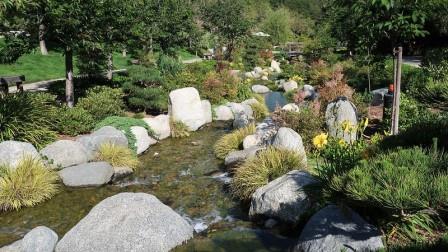 Acorus gramineus 'Ogon' growing alongside a stream in Japanese Friendship Garden. Picture courtesy K M from flickrCultivation/Propagation:
Acorus gramineus 'Ogon' growing alongside a stream in Japanese Friendship Garden. Picture courtesy K M from flickrCultivation/Propagation:
Acorus grows easily virtually throughout South Africa as long as it can be watered regularly. It does not perform well in dry soils and will need regular watering in the garden. This is especially important in the winter rainfall regions and in the drier summer rainfall regions of the country.
The green-leaved Acorus gramineus is fully hardy frost and temperatures down to -15°C, but the golden varieties may get scorched by severe frost, but will quickly shoot again in spring if the roots are well mulched in autumn.
The sweet flag is great in coastal landscapes because it tolerates salt winds with ease, and in these regions it thrives in beds on the shady side of the house.
Even though Acorus will grow in semi-shade and full sun, it does not like intense heat, so in very hot areas plant it where it will receive some shade during the hottest part of the day, or dappled sunlight throughout the day. Dry soils coupled with intense sunlight will scorch the foliage.
The plants will adapt to soils ranging from very acidic (pH 5.2 to 5.5) to alkaline (pH 8.1 to 8.5) and will flourish in most fertile garden soils, even heavy clay. Add generous amounts of compost to the beds before planting to help conserve water, and for a groundcover space the plants about 20 to 30cm apart, depending on the variety grown. Plants can take 2 to 3 years to reach their ultimate height, which may be taller than described, with a wider spread.
Propagation is easily done by digging up and dividing the tussocks at any time of year. Division of the clumps should be done every 3 to 4 years to maintain plant vigour.
 Problems, Pests & Diseases:
Problems, Pests & Diseases:
Insects and diseases are generally not a problem for this plant.
Too much summer sun or protracted dry conditions will cause the plants to look poorly, and scorching of the foliage can arise.
In too much shade growth will be stunted.
Warning:
Although no records of toxicity have been seen for Acorus gramineus, this species belongs to a family where most of the species are poisonous, at least in the fresh state. Always supervise small children in the garden, and discourage pets from chewing on plants.
Lilyturf - Liriope
 Liriope muscari 'Royal Purple' Description, History & Interesting Facts:
Liriope muscari 'Royal Purple' Description, History & Interesting Facts:
Liriope is a low-growing grass-like perennial which originates in East Asia - China, Japan and Korea; where it is found growing in shady forests, bamboo forests, scrub, grassy slopes and moist ravines. It is grown for its attractive glossy green leaves and unusual white, lilac or purple bell shaped flowers, carried on erect stems from mid to late summer and autumn. The flowers are followed by pea-sized black berries that persist well into winter. Variegated varieties will add golden, silver or white flashes of colour to shady gardens.
(Liriope muscari) is a hardy clumping perennial with narrow, arching, dark-green leaves and spikes of small violet-purple flowers. It grows +-30 cm high and 45cm wide and will tolerate dry periods.
(Liriope muscari 'Gold Band') has gold edged arching leaves with lavender flower spikes. The leaves are wider than other muscari varieties. It will grow +-35 cm tall and 40cm wide.
(Liriope muscari 'Variegata') has slender mid-green leaves with creamy yellow margins; it produces dense spikes of lavender flowers and grows +-20 to 40cm tall and 20 to 45cm wide. Variegated lilyturf is excellent to plant in the dry shade of trees.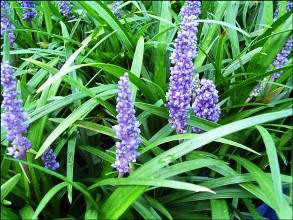 Liriope muscari. Picture courtesy www.acemondo.co.nz
Liriope muscari. Picture courtesy www.acemondo.co.nz
(Liriope muscari 'Monroe White') has green leaves with clustered spikes of white flowers. Mature plant s grow +-30cm tall and 45cm wide. It prefers partial to full shade, and protection from the wind; but will tolerate dry periods.
(Liriope muscari 'Royal Purple') has deep green leaves and dark purple flower spikes. It grows +-35 to 40cm tall and 45cm wide and will tolerate dry periods.
(Liriope muscari 'Evergreen Giant') is a large cultivar with beautiful dark green strap-like leaves and a profusion of violet-purple flower spikes. It can reach +-80cm to 1m tall with an equal spread, and grows in full sun to shade. It tolerates frost and coastal conditions with minimal care.
(Liriope muscari 'Big Blue') has arching dark green leaves and abundant clusters of blue flower spikes. It grows +-60cm tall and 60cm wide.
(Liriope spicata 'Frankin Mint') Green Carpet has darker green leaves than the other varieties with lilac flowers in summer. It grows to a height of +-45cm and is well suited as a ground cover as it forms a broad dense carpet.
(Liriope spicata) has green grass-like leaves and spikes of pale violet to lilac flowers. It is a vigorous spreading variety which grows +-40cm tall and tolerates heat, humidity, and prolonged dry spells. It is mainly used in mass plantings as a groundcover, and is excellent to plant on steep slopes where erosion control is needed.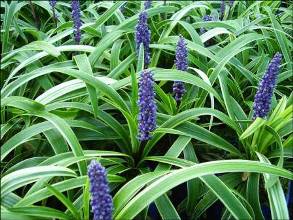 Liriope muscari 'Gold Band' Picture courtesy www.acemondo.co.nz
Liriope muscari 'Gold Band' Picture courtesy www.acemondo.co.nz
(Liriope spicata 'Silver Dragon') has striking white and green leaves and produces short dense spikes of pale lavender flowers in summer. It grows +-45cm tall and is well suited as a ground cover as it forms a broad dense carpet. It is very tolerant of adverse conditions and can be invasive.
In the Garden:
Lilyturf is low-maintenance and virtually pest free, making it a great choice for busy gardeners. It is excellent to plant as a groundcover underneath trees and shrubs; or as an edging for walkways and to define beds. It is often planted next to the foundations of buildings to help disguise and soften them; and is especially useful to plant on steep slopes because the dense mat of roots holds the ground exceedingly well, preventing soil erosion. With its finely textured foliage it provides a handsome backdrop for more colourful plants, making it a useful evergreen for mixed planters of seasonal annuals or perennials. Lilyturf looks great in any garden but is most effective in Japanese pebble gardens, woodland and cottage gardens.
The Commonwealth Scientific and Industrial Research Organisation (CSIRO) tested and listed the ignitability of Australian plants, and they listed Liriope muscari on List 2, as plants that regularly appear on many lists as fire retardant plants.
Cultivars vary in height from +-25cm to 1m tall. The two species most common in cultivation are Liriope muscari and Liriope spicata. L. muscari stays in a neat clump while L. spicata is a vigorous spreading variety. For this reason L. muscari is the preferred species for use as a border or in a flower bed and Liriope spicata works well as a groundcover in a large area and for erosion control on slopes.
 Liriope muscari 'Big Blue' Picture courtesy www.acemondo.co.nzCultivation/Propagation:
Liriope muscari 'Big Blue' Picture courtesy www.acemondo.co.nzCultivation/Propagation:
Lilyturf is evergreen and fully hardy to frost and cold temperatures; it grows best in regions with good summer rainfall, but can be grown in drier regions provided it is watered regularly. It grows well at the coast if it is planted in a sheltered position; except for a few, most varieties are not suited to very hot, humid conditions.
Lilyturf will adapt to most well-drained garden soils including clay, loam and sand; but prefers a light fertile, slightly acid to neutral soil, which is moist but well-drained. Most cultivars will grow in full sun, semi-shade and even deep shade; in hot regions plants do better in semi-shade.
Cut the leaves back right to the ground in early spring if they are looking worse for wear, mulch with compost and water regularly, and they will quickly shoot fresh new leaves.
Propagation is by lifting and dividing the roots of overcrowded clumps in autumn or spring. Although lilyturf will tolerate dry periods and grows well in the dry shade underneath trees and large shrubs, it looks at its best if watered moderately during hot, dry spells.
 Problems, Pests & Diseases:
Problems, Pests & Diseases:
No serious diseases or pests plague lilyturf but Anthracnose fungus sometimes causes reddish steaks in the leaves. Scale insects may cause unsightly reddish spots on leaves during late summer, but these can just be cut off. Slugs and snails are occasional pests.


